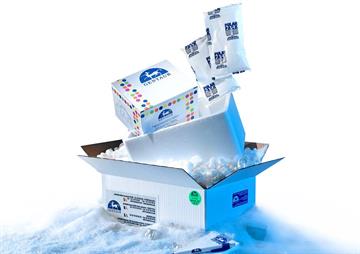Anti-Phospho-PTEN(S380) Rabbit pAb

Anti-Phospho-PTEN(S380) Rabbit pAb
380 EUR
In Stock
quantity
Produktdetaljer
Katalognummer: 1127 - GB114583
Produktkategori: Företag och industri > Vetenskap och laboratorium
Wuhan Servicebio TechnologyGentaur
Storlek: 100 μL
Related Products
STJ11101055
Anti-Phospho-PTEN-S370 antibody
This gene was identified as a tumor suppressor that is mutated in a large number of cancers at high frequency. The protein encoded by this gene is a phosphatidylinositol-3,4,5-trisphosphate 3-phosphatase. It contains a tensin like domain as well as a catalytic domain similar to that of the dual specificity protein tyrosine phosphatases. Unlike most of the protein tyrosine phosphatases, this protein preferentially dephosphorylates phosphoinositide substrates. It negatively regulates intracellular levels of phosphatidylinositol-3,4,5-trisphosphate in cells and functions as a tumor suppressor by negatively regulating AKT/PKB signaling pathway. The use of a non-canonical (CUG) upstream initiation site produces a longer isoform that initiates translation with a leucine, and is thought to be preferentially associated with the mitochondrial inner membrane. This longer isoform may help regulate energy metabolism in the mitochondria. A pseudogene of this gene is found on chromosome 9. Alternative splicing and the use of multiple translation start codons results in multiple transcript variants encoding different isoforms.
857.4 €
STJ11101064
Anti-Phospho-PTEN-S380 antibody
This gene was identified as a tumor suppressor that is mutated in a large number of cancers at high frequency. The protein encoded by this gene is a phosphatidylinositol-3,4,5-trisphosphate 3-phosphatase. It contains a tensin like domain as well as a catalytic domain similar to that of the dual specificity protein tyrosine phosphatases. Unlike most of the protein tyrosine phosphatases, this protein preferentially dephosphorylates phosphoinositide substrates. It negatively regulates intracellular levels of phosphatidylinositol-3,4,5-trisphosphate in cells and functions as a tumor suppressor by negatively regulating AKT/PKB signaling pathway. The use of a non-canonical (CUG) upstream initiation site produces a longer isoform that initiates translation with a leucine, and is thought to be preferentially associated with the mitochondrial inner membrane. This longer isoform may help regulate energy metabolism in the mitochondria. A pseudogene of this gene is found on chromosome 9. Alternative splicing and the use of multiple translation start codons results in multiple transcript variants encoding different isoforms.
857.4 €
STJ90498
Anti-Phospho-p38 (T180/Y182) antibody
p38 is a protein encoded by the MAPK14 gene which is approximately 41,2 kDa. p38 is localised to the cytoplasm and nucleus. It is involved in activated TLR4 signalling, the IL-2 pathway, toll-like receptor signalling pathways, the VEGF signalling pathway and 4-1BB pathway. This protein falls under the MAP kinase family. It acts as an integration point for multiple biochemical signals, and is involved in a wide variety of cellular processes such as proliferation, differentiation, transcription regulation and development. This kinase is activated by various environmental stresses and proinflammatory cytokines. p38 is expressed in the brain, heart, placenta, pancreas and skeletal muscle. Mutations in the MAPK14 gene may result in patellar tendinitis and lumbosacral lipoma. STJ90498 was affinity-purified from rabbit antiserum by affinity-chromatography using epitope-specific immunogen. This primary antibody specifically binds to endogenous p38 protein which only binds about T180/Y182 when T180/Y182 is phosphorylated.
504.6 €
A03008T369
Anti-Phospho-p107 (T369) RBL1 Antibody
Boster Bio Anti-Phospho-p107 (T369) RBL1 Antibody catalog # A03008T369. Tested in ELISA, IHC applications. This antibody reacts with Human, Mouse.
720 €
STJ117876
Anti-Phospho-PTK2-(Y576/577) antibody
This gene encodes a cytoplasmic protein tyrosine kinase which is found concentrated in the focal adhesions that form between cells growing in the presence of extracellular matrix constituents. The encoded protein is a member of the FAK subfamily of protein tyrosine kinases but lacks significant sequence similarity to kinases from other subfamilies. Activation of this gene may be an important early step in cell growth and intracellular signal transduction pathways triggered in response to certain neural peptides or to cell interactions with the extracellular matrix. Several transcript variants encoding different isoforms have been found for this gene.
857.4 €
Håll dig uppdaterad! Visa tidigare publikationer

By: Author , 2 Comment
Anaplasmos hos hundar och katter – allt du behöver veta
23 August 2025

By: Author , 2 Comment
Solbränna – hur leker man säkert i solen?
16 August 2025

By: Author , 2 Comment
Biologiska läkemedel – Modernitet inom farmaci
1 August 2025

By: Author , 2 Comment
Icke-steroida antiinflammatoriska läkemedel – viktig information om populära läkemedel
22 July 2025








